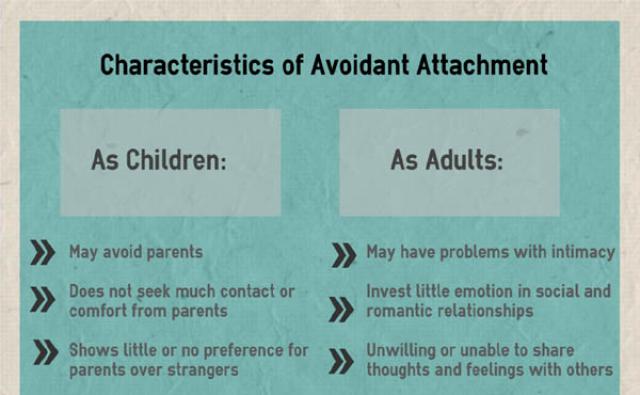Avoidant Attachment Style

. Secure Attachment. If parents are consistent, available, and responsive, their children need to do little to maintain security in their parental relationships.
Their secure attachment styles enable them to connect easily, to accurately perceive and react to other people, and to control their emotions and behaviors in healthy ways. Avoidant Attachment. When parents are rejecting of a child’s need for closeness and reassurance, the child will learn to deny their own negative emotions and needs for close relationships.
People with an avoidant attachment style have a deep-rooted fear of losing their autonomy and freedom in a relationship. Subconsciously, they equate intimacy.
They will maximize their feelings of security in their parental relationships by developing avoidant attachment styles (also called “dismissing” among adults) and getting parental approval by winning at things like academics and sports and acting self-assured and confident. Attachment. When parents are inconsistent in dealing with their children—sometimes warm and loving and at other times cold and rejecting—the children will cope by learning to carefully monitor the parents’ moods so that they can feel secure by heading off rejection before it happens. These children develop anxious attachment styles (also called “preoccupied” among adults) so that they can remain on guard for any signs of rejection.
They try to stay as close as possible to their loved ones, don’t like to let go, and have a hard time dealing with loss, especially if they cannot make sense of why the loss happened. Disorganized Attachment. When parents are frightened (traumatized, victimized, terrorized) or frightening (, abusive, rageful), children will not be able to develop organized ways of coping or adapting. Is too unpredictable, so they develop “disorganized” attachment styles (called “fearful” among adults). One system of measuring attachment styles, the Adult Attachment Interview, calls this style “unresolved” in relation to loss and trauma. These individuals have a hard time dealing with losses later in life because they were never able to effectively resolve losses earlier in their lives.
This is similar to , in which the greatest predictor of developing the disorder after a trauma in adulthood is having unresolved traumas earlier in life. Research shows that relative to people with secure styles, those with one of the insecure styles (dismissing avoidant, preoccupied/anxious, fearful or disorganized) will experience more grief and less (Cohen & Katz, 2015). Dismissing/avoidant people, in particular, are likely to report less post- growth after the death of a loved one. They tend to suppress their negative feelings and to convert those negative (disowned) emotions into physical symptoms like headaches or abdominal distress (Wayment & Vierthaler, 2002).
In contrast, those with preoccupied styles almost never suppress their emotions and experience more intense prolonged grief (Lai et al., 2015; Maccallum & Bryant, 2018). These results are the same regardless of whether the lost loved one was a human or a pet (Brown & Symons, 2016). Based on this body of research and the theory describing each of the styles, we should expect that those who have anxious/preoccupied styles will be heavily impacted by loss and that the associated negative feelings will last longer.
They also may experience more intense and lasting over the situation and perhaps even at the lost loved one. As their narrative (the story they tell themselves) about the loss grows, they may perceive that their grief continues to intensify for a period after the loss, as opposed to getting better. Those with avoidant/dismissing styles may appear to cope better with grief after a loss, but this really depends on how you define 'better' coping. Yes, they are likely to acknowledge less distress and are less likely to admit negative feelings to others. They are likely to suppress their unwanted feelings and externally appear fine. Some may even think that the dismissing person looks callous or uncaring. However, suppressing feelings in this way is not healthy and may result in more health concerns and dealing with more emotional and relationship problems down the road.
The take-home messages here are:. People with different attachment styles are likely to grieve and express themselves in different ways after a significant loss. We should not judge others harshly for how they behave during the grief period.
Some people may shut down and pull away, others may dramatize and express their feelings deeply and openly, and yet others may appear angry and irritable. Remember that how people respond is not always a good indicator of how much they loved (or did not love) the deceased.
